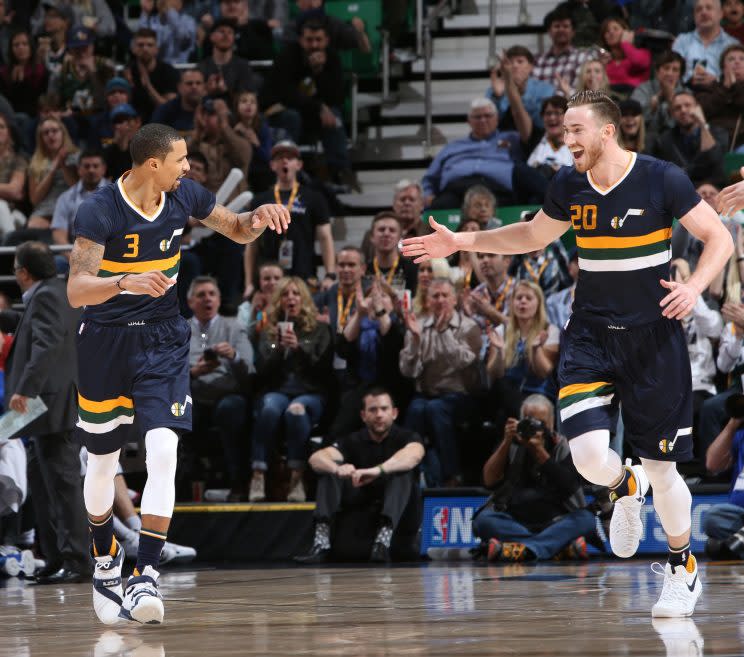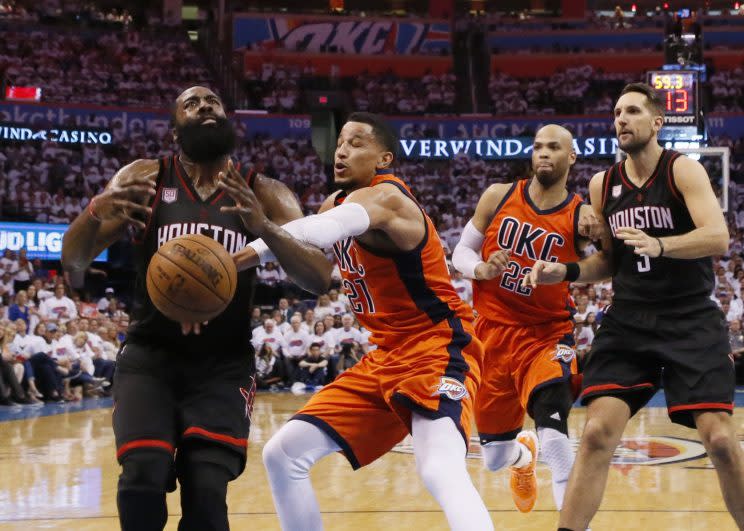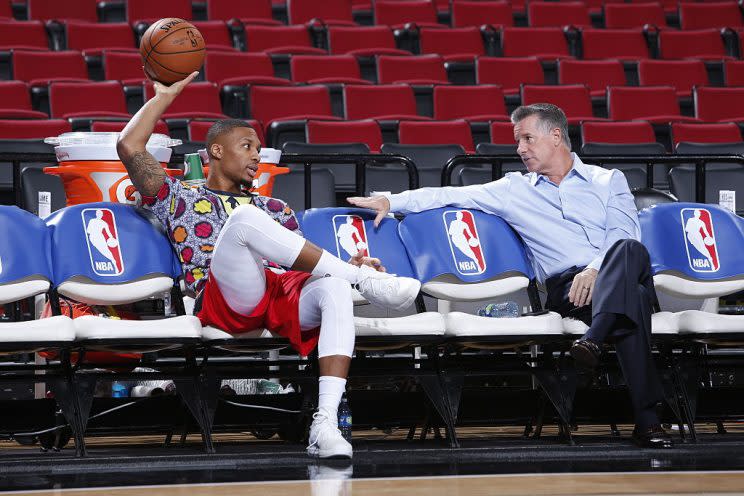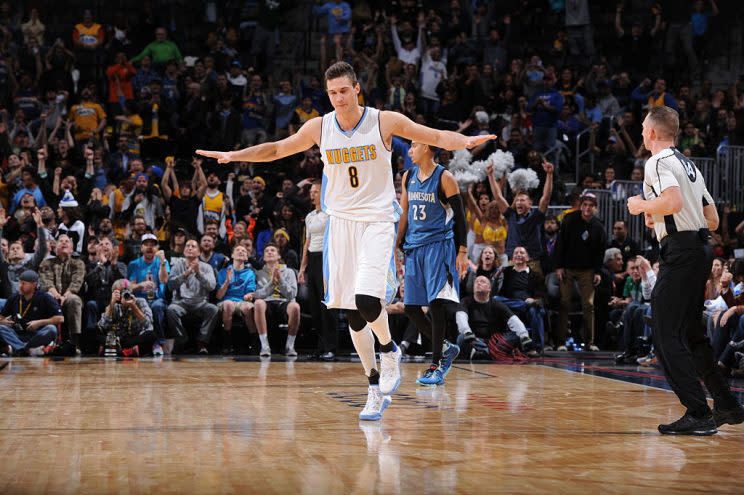NBA Free Agency Shopping Lists: Northwest Division
Free agency is a complicated time full of misdirection, brief opportunities and a whole lot of persuasion. We’ve put together these shopping lists to ensure every team stays on track.
Utah Jazz
2016-17 record: 51-31, eliminated in the Western Conference semifinals
Unrestricted free agents: Gordon Hayward, George Hill, Shelvin Mack, Jeff Withey
Restricted free agents: Joe Ingles
It feels downright mean that this is where the Jazz find themselves. For a handful of years, a front office led by Kevin O’Connor and Dennis Lindsey has done so many things right: drafting and developing a homegrown All-Star in Hayward, taking Rudy Gobert at No. 27 overall and building him into an All-NBA Second Teamer and Defensive Player of the Year runner-up, making enough savvy trades and signings to build a roster deep enough to win 51 games despite coach Quin Snyder only having his expected starting five together for 14 games last season and winning the franchise’s first playoff series since 2010 by beating the Los Angeles Clippers in a Game 7 in their own gym.
And then you run into the Warriors, and four games later, you’re left staring up at the lights, and into the possibility of watching your foundation crumble.
[Fantasy Football is open! Sign up now]
Billboards and paeans aside, Hayward’s taking meetings with the Miami Heat and Boston Celtics. There is a very real chance that he decides the extra coin he can make by staying in Salt Lake City — a five-year, $180 million deal that would be about $44 million more than he could make elsewhere, per Bobby Marks of The Vertical — isn’t as attractive as the opportunity to play in an environment that might provide a more attractive path to continued contention than the one in Utah.

After spending a season watching virtually every non-Gobert player expected to help him turn the Jazz into a legitimate contender battle myriad injuries — shooting guard Rodney Hood, power forward Derrick Favors, swingman Alec Burks and unrestricted-free-agent-to-be point guard George Hill — maybe Hayward worries the Jazz are less an ascendant power than one whose past potential might outstrip its future projection. A Hayward exit wouldn’t necessarily cripple a Jazz team that has Gobert locked up for several more years, but it would leave Utah reeling, needing to completely reorient its offense and facing serious questions about the proper price points for their other free agents.
Despite missing 33 games last season battling a persistent toe injury, Hill’s likely to draw significant interest on the open market as a ball-handler capable of defending both backcourt positions and spotting up off the ball. When he was on the floor, the Jazz were excellent, and he made so much sense next to Hayward. But if Hayward’s on the way out, will Lindsey and company feel comfortable spending $20 million or so per year on someone who’s played fewer than 50 games twice in the last three seasons and who seems much more suited for a complementary role than a starring one — especially with 2014 first-round pick Dante Exum waiting in the wings? Then again, that decision-making calculus might be backward; Hill and Hayward are very tight, and a pledge to retain the former might be a prerequisite in getting a commitment from the latter.
Ingles was a valuable contributor to the Jazz, serving as a sharpshooting swingman, savvy ball-mover and tough defender. But if the 30-year-old Aussie’s market goes past midlevel-exception money and reaches eight figures per season, the Jazz might be better served trying to find higher-upside ways to spend that money, as much as they’d like to retain his services.
Bringing back all three would vault the Jazz over the $99 million salary cap and within hailing distance of the $119 million luxury tax, and that’s before factoring in potential rookie-scale extensions for eligible class of 2014 draftees Hood and Exum. It’s exceedingly unlikely Utah will pay that tab, meaning their best-case scenario is probably bringing back two of the three — a decision that could prove awfully tricky, considering the competing interests at work here:
Another source confirms that Gordon Hayward really wants the Utah Jazz to bring back George Hill. His decision could hinge on that.
— Jody Genessy (@DJJazzyJody) June 30, 2017
The Jazz are in a pickle because they're trying to get a cheaper veteran than George Hill so they can pay Gordon Hayward and Joe Ingles.
— Jody Genessy (@DJJazzyJody) June 30, 2017
Sidenote: Hayward and Ingles have the same agent. https://t.co/M5jUBUO1Mq
— Sam Amick (@sam_amick) June 30, 2017
Potentially complicating matters: the Jazz are still about $16 million under the 2016-17 salary cap, giving them financial flexibility to take on a big contract for a player that might help … so long as they do it before midnight Eastern time, when the league calendar flips to 2017-18. They’ve reportedly been eyeing trades for a veteran point guard, most notably Ricky Rubio … which might complicate things juuuuust a tad on the Hill front and could wreak havoc on the possibility of retaining Hayward.
Utah’s got a lot at stake and a lot of balls in the air as the clock winds down. Lindsey, for his part, is projecting calm.
“Many times, what happens is, you capitulate to pressure and then you overreach,” the Jazz GM recently told reporters. “We want to stick to our fundamentals of team building — mindset, culture, skills, fits, value adds, contract, production. We’re quite confident.”
Whether that confidence is founded could be one of the biggest storylines of the summer of 2017.

Oklahoma City Thunder
2016-17 record: 47-35, eliminated in the first round
Unrestricted free agents: Taj Gibson, Norris Cole, Nick Collison
Restricted free agents: Andre Roberson
The Thunder enter the summer with just under $113 million in guaranteed salary on the books — meaning they’re about $14 million over the cap, and about $6 million under the luxury tax line — so they don’t have very much financial flexibility. In a perfect world, they’d bring back both Gibson (a stalwart veteran four who helped on both ends of the floor after his trade-deadline acquisition) and Roberson (an All-Defensive Team perimeter stopper who makes life miserable for opposing scorers every night). But doing so means going very deep into the luxury tax, which could be a non-starter for a team that’s already paid the tax twice in the last three years and doesn’t want to fall prey to the dreaded repeater tax incurred when you’re a taxpayer four times in five seasons.
Vaulting into the tax would be especially damaging because going more than $6 million over the tax line (the so-called “apron”) would cost the Thunder the right to use the biannual exception of $3.3 million per year and would limit the amount of their midlevel exception to just under $5.2 million per year for up to three years, as opposed to the $8.4 million over four that non-taxpayers can offer. When you’re capped out, retaining the ability to use those exceptions to add talent is really important, and that could mean the Thunder are in for some restructuring.
The most preferable path to creating a little bit of breathing room is probably finding a taker for the two years and $36.5 million owed to reserve scorer Enes Kanter. Given the Turkish big man’s defensive struggles, though, that price tag might be a bit rich without additional sweeteners. The Thunder might struggle providing those, as they already owe a lottery-protected 2018 first-round pick to the Jazz (as part of the deal that sent Kanter to OKC) and a top-20-protected 2020 No. 1 to the Orlando Magic (who acquired it from the Philadelphia 76ers, who took it in exchange for forward Jerami Grant).
[Follow Ball Don’t Lie on social media: Twitter | Instagram | Facebook | Tumblr]
If general manager Sam Presti can’t offload Kanter (or, less likely, about-to-become-$21-million-man Victor Oladipo) or find another ingenious path to cap flexibility, the Thunder might be forced to bid farewell to Gibson — and maybe even Roberson, if some suitor comes calling with a front-loaded restricted free agent offer sheet — and try to find defensive replacements with the midlevel exception.
The market might push players like Toronto’s Patrick Patterson and Memphis’ JaMychal Green out of MLE range; if not, OKC could do worse in replacing Gibson. Similarly, Tony Allen, Luc Richard Mbah a Moute and Thabo Sefolosha represent longer-in-the-tooth, lower-grade options for life after Roberson, but they might offer some of the flavor the Thunder want at the price they need.
At some point, it’d also be nice for the Thunder to find a backup for Russell Westbrook who can keep OKC from cratering when he needs to rest. (Which he does sometimes, with the Thunder very much unable to stay afloat when he did so.) The Shelvin Macks and Langston Galloways of the world might not be available for the biannual exception, and Oklahoma City might need to target bigger fish with the MLE, which could leave Presti once again scraping the minimum market in search of a lottery ticket.
And speaking of the just-crowned MVP …

Presti reportedly plans to offer him a monster five-year, $200-plus million super-max Designated Veteran Player Extension as soon as free agency opens. If Westbrook takes it, the Thunder have their centerpiece locked in through 2022. If he doesn’t, for the second time in three years, Presti will have to decide whether or not to put a beloved franchise player on the trade market to avoid potentially losing him for nothing the following summer. Things could soon get very, very interesting in Oklahoma.
Portland Trail Blazers
2016-17 record: 41-41, eliminated in the first round
Unrestricted free agents: None
Restricted free agents: None
Like the Thunder, Portland’s got zero financial flexibility. Negative wiggle room, in fact. After paying C.J. McCollum $106 million, signing Evan Turner, matching Brooklyn’s offer sheet for Allen Crabbe, and bringing back restricted free agents Meyers Leonard and Maurice Harkless last summer, the Blazers enter July with $142.5 million in guaranteed salary committed for next season, according to Mark Deeks of ShamSports.com. And they’re in line to pay nine figures’ worth of salary that keeps them capped out and luxury-tax-adjacent in each of the next two seasons, as well.
Footing gigantic tax bills for a team that can contend is one thing. But the Blazers finished .500, got blasted in the first round by Golden State and seem to have a couple of quantum leaps to make before they can claim with a straight face they’re within sniffing distance of the West’s upper echelon. Something’s got to give, right?

It’s possible that one of those leaps will come with a full season of pairing the high-octane backcourt of McCollum and Damian Lillard with a healthy Jusuf Nurkic, who became a folk hero after joining the team before the trade deadline. In Nurkic’s minutes, Portland outscored the opposition by a whopping 9.3 points per 100 possessions during the regular season before he went down with a fractured right fibula.
Other avenues toward a leap, though? Those are harder to figure. The Blazers paid through the nose to ensure they had depth on the wing, knowing how hard it is for NBA teams to come by quality swingmen these days, but now might find themselves unable to offload either Crabbe or Turner. They’re also unwilling to move the more cost-effective and defensively useful Harkless and Al-Farouq Aminu. And with 2017 first-rounders Zach Collins and Caleb Swanigan joining Nurkic, Leonard, Noah Vonleh and Ed Davis on the roster, the frontcourt’s now awfully crowded without too much in the way of a clearly defined pecking order. (That Nurkic and Vonleh are both eligible for extensions of their rookie deals, and will enter restricted free agency next summer if Portland doesn’t re-up, only complicates matters.)
Neil Olshey has done well to compile a pretty interesting collection of players capable of producing a top-10 offense; if Nurkic’s late-season surge is the real deal and Aminu’s healthy, the Blazers’ defense might not be as hopeless as it often seemed last season. But he spent plenty of Paul Allen’s money to do it, and barring major internal improvement from multiple pieces, it’s tough to see a way for Portland to reach the next level without a significant shake-up via trade.

Denver Nuggets
2016-17 record: 40-42
Unrestricted free agents: Danilo Gallinari, Roy Hibbert
Restricted free agents: Mason Plumlee
In the middle of December, coach Mike Malone reinserted Nikola Jokic into Denver’s starting lineup. From that point on, nobody — not the Warriors, not the Rockets, not the Cavs: nobody — scored more points per possession than the Nuggets, who sliced and diced opposing defenses behind the brilliant playmaking and efficient scoring of their 6-foot-11 Serbian center.
There was just one problem. Over that same stretch, nobody — not the Lakers, not the Suns, not the Kings: nobody — allowed more points per possession than the Nuggets, who saw their late-season push for the West’s eighth and final playoff spot scuttled by a buzzer-beating 3-pointer to cap off a 50-point triple-double by Westbrook. Denver’s got some tantalizing young passers, shooters and finishers on board, but the Nuggets need some defensive steel if they’re to make a serious push into the Western playoff picture.
So, naturally, they’ve been linked to Kevin Love.
Denver emerged ahead of last week’s draft as the wheel-greasing third team in prospective deals that would land Paul George in Cleveland, Love in Denver, and a slew of future draft picks, young players and expiring contracts in Indiana. A Love-Jokic frontcourt would allow Denver to play a brand of five-out ball that could be damn near un-guardable. It wouldn’t, however, seem to address that nettlesome issue of not being able to freaking stop anybody — especially if one of the pieces moving to Indiana is shooting guard Gary Harris, a legitimate two-way contributor who took major steps forward last season as a perimeter defender, shooter and cutter.
Harris helps, and does so at a position that’s super-thin around the league, which is why Denver doesn’t really want to move him. He’s also eligible for an extension of his rookie deal, and might soon cost nearly as much as Love, which is why the Nuggets would probably have to at least entertain the notion, even if a lineup of something like Love, Jokic, Wilson Chandler, Jamal Murray and Emmanuel Mudiay doesn’t seem particularly likely to strike fear into the hearts of the Warriors, Spurs or Rockets.
Love’s a name that sticks because Denver needs to figure out what it’s doing at power forward. Jokic firmly established himself as the Nuggets’ center of the future — this is why Nurkic is now in Portland, instead of being unhappy next to Malone on the bench — but Denver hasn’t yet found the right sort of fit at the four next to their super-skilled but somewhat slow-footed and ground-bound playmaker. A defensively versatile type who doesn’t demand No. 1 option touches would be wonderful.
Is Denver willing to shell out max or near-max money for 32-year-old Paul Millsap while knowing they’ll soon need to shell out big paydays for Harris and Jokic (a second-round pick in 2014 who didn’t come over until 2015, signing a four-year deal with a team option for 2018-19, but who could look to tear that up next summer to lock him up long-term as soon as possible)? If the Raptors decide to move on from Serge Ibaka, the soon-to-be-28-year-old could be a dynamite fit. (Kentucky product and former Jazz reserve Trey Lyles, imported on draft night, could factor into the solution here, too, though he shouldn’t be counted on to provide the whole answer himself.)
If the Nuggets do decide to look elsewhere at the four, it probably means they’re moving on from Gallinari, who bounced back in a big way last season and has proven when healthy — two heavy words — to be a valuable shooter and face-up playmaker for teams seeking stretch fours who already have defensively viable fives.
With Mudiay struggling in his second season and rising sophomore Murray perhaps not ready for full-time point guard duty, Denver also figures to be in the market for a veteran point guard. How high-caliber an option they’ll be able to pull on the open market remains to be seen. Chris Paul’s already in Houston; Utah and San Antonio will probably fight over Hill; and the Pelicans pretty much have to keep Jrue Holiday. If Toronto balks at offering five years or max money, Kyle Lowry might be an interesting name to keep an eye on as a hard-nosed defender who can shoot, share, score and cut to wind up on the other end of some of those sweet, sweet Jokic dimes.

Minnesota Timberwolves
2016-17 record: 31-51
Unrestricted free agents: Omri Casspi, Adreian Payne, Brandon Rush
Restricted free agents: Shabazz Muhammad
The Wolves already made one big splash, pulling off a draft-night blockbuster fleecing of the Chicago Bulls to import All-NBA swingman Jimmy Butler and give Minnesota a core that rising superstar Karl-Anthony Towns calls “what dynasties are made of.” There’s a lot of space, though, between the destination of a dynasty and the starting point of a 31-win roster. Getting there will require even more bold moves.
Like, say, trading incumbent point guard Ricky Rubio to a team with cap space (hello, Utah) to create even more cap space to pursue a potential upgrade at the point who can space the floor to a degree the Spaniard’s never been able to? Like, say, Lowry, whom Butler may or may not be trying to recruit to join him in Tom Thibodeau’s backcourt? Or Hill, who might see Minnesota as a viable new home if the Jazz and Spurs look elsewhere?
With sweet-shooting guard Zach LaVine shipped to Chicago in the Butler deal, a Wolves team already lacking enough capable marksmen needs more shooters. Lowry or Hill would certainly help there. If Hill rejoins the Spurs, San Antonio’s Patty Mills, who shot 41.3 percent from deep last season, might be available at a lower price point, too, though I’d be leery of considering him an upgrade over Rubio’s playmaking and defensive excellence.
They’ve long been rumored to be interested in Millsap — who, for what it’s worth, is less a “stretch” four than a playmaking power forward, having shot better than league-average from 3-point range just once in his career (and less than 32 percent in the last two seasons) — as a smart, defensive-minded veteran complement to Towns. But shelling out a big-money four-year deal for him ahead of forthcoming max extensions for Wiggins (next summer) and Towns (in 2019) might make owner Glen Taylor a little green around the gills.
But that’s the price of trying to level up in the NBA. The Wolves showed on draft night that they’re serious about becoming a rising force. Now it’s up to them to put some money behind that mission.
More NBA Free Agency Shopping Lists:
Northwest Division • Pacific Division • Southwest Division
Atlantic Division • Central Division • Southeast Division
More NBA coverage:
– – – – – – –
Dan Devine is an editor for Ball Don’t Lie on Yahoo Sports. Have a tip? Email him at devine@yahoo-inc.com or follow him on Twitter!



